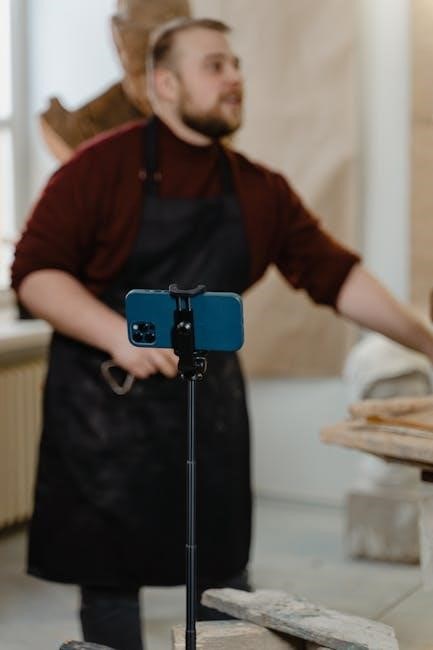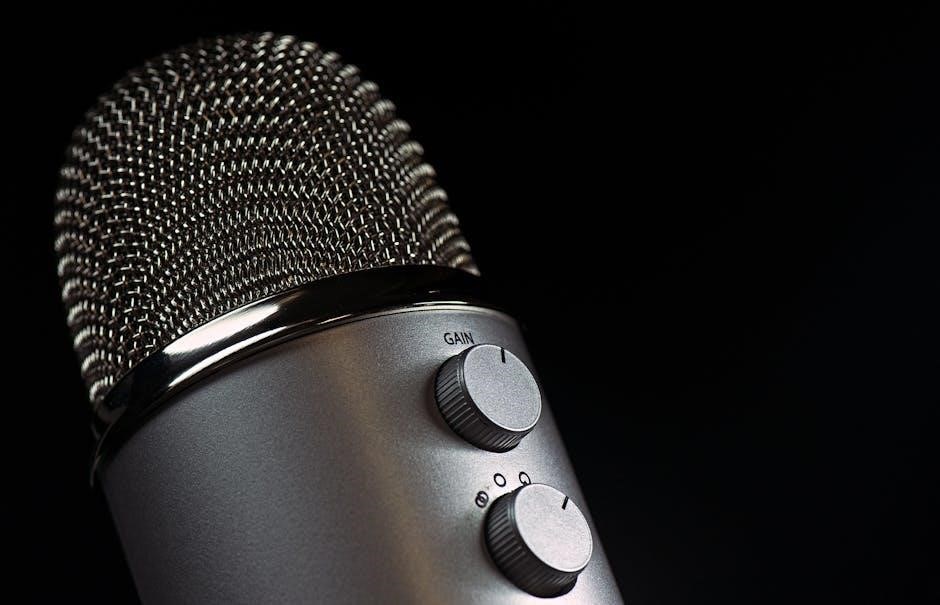Professional recording studio equipment is essential for achieving high-quality sound and precise audio control. This guide provides a comprehensive list of gear needed for professional recordings, ensuring clarity and accuracy in every session.

1.1. Overview of Essential Gear for High-Quality Recordings
Professional recording studio equipment ensures high-quality sound capture and processing. Essential gear includes microphones, audio interfaces, studio monitors, and acoustic treatment. These tools are vital for capturing accurate sound, managing audio signals, and ensuring clear playback. Additionally, digital audio workstations (DAWs) and MIDI controllers are crucial for production. Accessories like cables, stands, and hardware components complete the setup. Each piece plays a critical role in achieving professional-grade recordings, making it essential to invest in reliable and high-performance equipment tailored to specific needs.
1.2. Importance of Investing in Professional-Grade Equipment
Investing in professional-grade equipment is crucial for producing high-quality recordings. It ensures clarity, accuracy, and reliability, which are essential for professional results. High-end gear reduces noise and distortion, providing precise sound reproduction. Additionally, professional equipment enhances workflow efficiency, allowing for better creativity and consistency. While initial costs may seem high, the long-term benefits of durability and superior performance make it a worthwhile investment. Professional-grade equipment is integral to maintaining industry standards and delivering exceptional audio quality in any recording environment.

Essential Equipment for a Professional Recording Studio
A professional studio requires high-quality microphones, audio interfaces, studio monitors, and acoustic treatment to ensure accurate sound reproduction and optimal recording conditions.
2.1. Microphones: Dynamic, Condenser, and Ribbon Options

Professional recording studios rely on three main microphone types: dynamic, condenser, and ribbon. Dynamic mics are durable and ideal for high-SPL applications like drums or live vocals. Condenser mics offer detailed sound reproduction, perfect for capturing acoustic instruments and subtle vocals. Ribbon mics provide smooth, warm tones, often used for vintage-style recordings. Each type serves specific purposes, and having a variety ensures versatility in capturing diverse audio sources. Investing in quality microphones is crucial for achieving professional-grade recordings.
2.2. Audio Interfaces: Key to Connecting Mics and Instruments
Audio interfaces are the backbone of modern recording, bridging analog and digital worlds. They connect microphones, instruments, and other gear to your computer. High-quality interfaces ensure low latency, crystal-clear sound, and reliable performance. When choosing, consider USB connectivity, built-in preamps, and the number of inputs/outputs needed. Budget-friendly options exist, but professional studios often opt for high-end models with advanced features. A good interface is essential for capturing high-fidelity audio and maintaining creative workflow. Invest wisely, as it directly impacts sound quality and studio efficiency.
2.3. Studio Monitors: Accurate Sound Reproduction
Studio monitors are vital for accurate sound reproduction, ensuring mixing and mastering decisions are precise. High-quality monitors deliver flat frequency responses, minimizing coloration. Look for near-field or far-field options, depending on your space. Active monitors, like KRK or Yamaha, offer convenience with built-in amplifiers. Passive models require external power but can be more flexible. Brands like Genelec and Focal are trusted for their clarity. When choosing, consider size, power, and connectivity to suit your studio needs. Accurate monitoring is the backbone of professional recordings, ensuring your mixes translate well across all playback systems.
2.4. Acoustic Treatment: Enhancing Studio Sound Quality
Acoustic treatment is crucial for optimizing studio sound quality by controlling echo, flutter, and unwanted reverberations. Materials like acoustic panels, bass traps, and diffusion panels absorb or scatter sound waves, reducing reflections. Proper treatment ensures accurate monitoring and mixing. Strategic placement of these elements minimizes external noise interference. A well-treated room delivers consistent audio reproduction, essential for professional recordings. Investing in acoustic treatment is as important as high-quality gear, ensuring your studio environment supports your creative and technical goals.
Software and Digital Tools
Professional recording relies on software like DAWs (Digital Audio Workstations) and MIDI controllers. These tools streamline recording, editing, and mixing processes, enabling precise control over audio productions and creativity.
3.1. Digital Audio Workstations (DAWs): Choosing the Right One
Choosing the right DAW is crucial for professional recording. Popular options include Ableton Live, Logic Pro, and Pro Tools, each offering unique features. Consider compatibility, ease of use, and specific needs like MIDI editing or post-production tools. Many DAWs offer free trials, allowing you to test before committing. Compatibility with your operating system and hardware is essential for seamless integration. Budget and scalability are also key factors, as some DAWs cater to beginners while others are tailored for advanced users. Selecting the right DAW ensures efficient workflow and high-quality audio production.
3.2. MIDI Controllers: Enhancing Workflow and Creativity
MIDI controllers are indispensable for modern music production, offering hands-on control over virtual instruments and effects. They enhance creativity by allowing intuitive manipulation of parameters like velocity, pitch, and modulation. Keyboards, pads, and knobs provide tactile interaction, speeding up the composition process. Many controllers are DAW-specific, ensuring seamless integration, while others offer universal compatibility. Portable options are ideal for producers on the go, while studio-focused models deliver advanced features. Investing in a MIDI controller streamlines workflow, enabling artists to focus on creativity rather than mouse clicks, resulting in more dynamic and engaging musical productions.

Additional Studio Accessories
Essential studio accessories like high-quality cables, sturdy stands, and ergonomic furniture ensure efficient workflow and comfort during long recording sessions, supporting overall studio functionality and productivity.
4.1. Cables, Stands, and Other Hardware Essentials
Cables, stands, and other hardware essentials are the backbone of a functional recording studio. High-quality XLR, TRS, and USB cables ensure reliable audio signal transmission, minimizing interference and hum. Sturdy microphone stands and boom arms provide stability for precise placement, while pop filters and cable organizers maintain a clutter-free environment. Additional hardware like patch bays and signal splitters enhance connectivity, allowing seamless integration of multiple devices. Investing in durable, professional-grade accessories ensures longevity and optimal performance, making them indispensable for any professional setup.
Setting Up Your Studio
Setting up your studio requires strategic planning and attention to detail. Ensure proper space selection, optimize layout for workflow efficiency, and prioritize acoustic treatment for superior sound quality.
5.1. Choosing the Right Space for Your Studio
Selecting the ideal space for your studio is crucial for achieving professional-quality recordings. Consider factors such as room size, shape, and natural acoustics to minimize echo and external noise. A room with minimal outside interference and adequate space for equipment setup is ideal. Additionally, ensure the area is easily accessible and has proper ventilation. Avoid spaces near high-traffic areas or those prone to vibrations, as these can compromise sound quality. Opt for a room that allows for flexible layout adjustments to accommodate different recording needs and setups effectively.
5.2. Optimizing Studio Layout for Efficiency
A well-planned studio layout is essential for maximizing efficiency and creativity. Ensure the mixing console and monitor speakers are centrally positioned for optimal listening and workflow. Place microphones, instruments, and equipment in easily accessible locations to streamline the recording process. Incorporate acoustic treatment to minimize sound reflections and echoes. Keep cables and wires organized using cable management systems to reduce clutter and potential noise interference. Designate specific areas for instruments, amplifiers, and outboard gear to maintain a tidy and functional workspace. Consider natural light and ergonomics to create a comfortable environment that fosters productivity. Regularly assess and adjust the layout to meet evolving needs and equipment requirements.

The Professional Recording Studio Equipment List PDF
The professional recording studio equipment list PDF is a valuable resource, detailing essential gear like microphones, audio interfaces, monitors, and acoustic treatments to ensure high-quality recordings.
6.1. What to Expect in a Comprehensive Equipment Guide
A comprehensive equipment guide for professional recording studios offers detailed lists and descriptions of essential gear, including microphones, audio interfaces, studio monitors, and acoustic treatments. It also covers software tools like DAWs and MIDI controllers, providing insights into their roles in the recording process. The guide typically includes setup tips, maintenance advice, and troubleshooting common issues. Additionally, it may feature recommendations for accessories like cables, stands, and ergonomic furniture. This resource is designed to help both beginners and experienced professionals make informed decisions when building or upgrading their studio, ensuring optimal performance and sound quality.
6.2. How to Use the List for Building or Upgrading Your Studio
Use the professional recording studio equipment list PDF to systematically assess your current setup and identify gaps. Start by evaluating your needs, budget, and the type of projects you plan to undertake. Prioritize essential items like microphones, audio interfaces, and monitors, then gradually add secondary gear. Organize your workspace to optimize workflow and sound quality. Refer to the guide for setup tips and troubleshooting common issues. Regularly update your equipment based on evolving standards and personal growth as a professional. This approach ensures your studio remains functional, efficient, and capable of delivering high-quality recordings.
